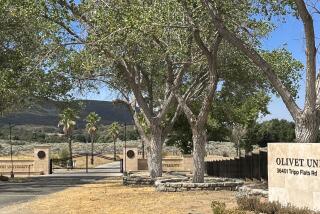Suit Charges Race Bias at Prep School : Education: Former director of Van Nuys campus says Japanese owner ordered him to exclude blacks and Salvadorans.
The founding director of an international prep school in Van Nuys has filed a $1.1-million lawsuit against the school, saying he was fired for refusing to heed his Japanese employer’s orders to keep out black and Salvadoran students.
The school, known both as the Stratford Preparatory School and the California Preparatory School, is an offshoot of one of the largest and most prestigious high schools in Japan. It was established in 1989 to give Japanese students a chance to study abroad and learn the customs and traditions of the United States, and for American students to study at a prep school with foreign students.
But former director Eizo Masuda, 52, alleges that he was fired in February, 1991, because he refused to comply with the orders of Motoaki Yamamori, the Japanese school owner who had asked him to establish the school less than a year earlier.
Yamamori insisted that Masuda “perform illegal actions,” such as refusing to admit black and Salvadoran students, and make false student visa applications so that Japanese students could get into the country, according to the lawsuit and a sworn declaration by Masuda.
Masuda’s lawsuit, filed in November, 1991, came in response to a suit the school filed against him several months earlier, alleging that he used petty cash without permission and failed to perform his duties properly as director of the school. The school is seeking at least $40,000 in reimbursements and damages from Masuda.
Administrators, teachers and students at the tiny campus just off Sepulveda Boulevard had no comment Monday. Bookkeeper Lani Rey said the school’s director and spokesman were out for the week.
“I can only state that there has been no discrimination here,” Rey said.
Schools officials said recently that they are planning to close the campus, and staff members who asked not to be identified said Monday that the school may remain open only for Japanese students. Rey would not comment on either possibility.
The school’s lawyer, Gerard C. Mogab, also was out of town, and did not return calls. In an April letter to Masuda’s lawyer, Mogab said that the school “at all times . . . has included a significant percentage of blacks and Hispanics (as well as other minorities).”
Masuda, however, alleges that Yamamori, after visiting the school and noticing that there were more minority than white students, told him repeatedly to get rid of minority students and not allow others to enroll. Yamamori also said he did not want between 35 and 55 Salvadoran students who had expressed an interest in being exchange students at the school, Masuda said in an interview Monday.
“He wanted white students, blond, with blue eyes,” Masuda said. “He said he couldn’t advertise with black students, he would get a negative response from Japanese parents.”
Masuda said in the interview that Yamamori told him Japanese parents have become increasingly afraid of sending their children to schools with minority students because of what they read and see on television about U.S. cities.
At first, according to Masuda, he refused to cooperate with the orders, telling Yamamori that he could get in trouble, and that it was wrong to discriminate against minority students.
“I came here, I was discriminated against,” said Masuda, who came to the United States in 1968 and is a permanent U.S. resident. “Anybody making judgments against you on the way you look is totally wrong. If you are an incompetent student, then fine . . . but to discriminate just on color is totally wrong. I would tell him this . . . and he would back off. But then a week later, two weeks later, he’d say: ‘You are not doing what I asked you to, and you will pay the consequences.’ ”
On. Oct. 6, 1989, a top aide to Yamamori sent Masuda a fax regarding new applicants to the school, the lawsuit alleges. According to a translation entered into the court record, Masuda was given these “special instructions”: “We do not accept any black applicants at our school. . . . We do not accept the 35 El Salvadorans to our school.”
It is against state and federal civil rights laws to discriminate against a student solely on the basis of color or ethnicity, said Eugene Mornell, executive director of the Los Angeles County Human Relations Commission.
Masuda and his lawyer, Kenneth G. Griffin, also allege that the school’s suit accusing Masuda of impropriety was filed after he threatened to sue the institution, and was only done to intimidate him into being quiet. Masuda said the school had bookkeepers in Los Angeles and Japan who would notice any discrepancy, and that the other charges are groundless.
In the school’s suit, Masuda also is accused of purchasing three horses for student use that were not ridable and wild, and for making illegal building modifications at an apartment building that housed students, such as installing washing machines in the basement and using an apartment as a kitchen or cafeteria.
As the countersuit against the school moves closer to trial, Yamamori has refused to cooperate, saying that Japanese law protects him from being served with court papers by mail because he is a Japanese citizen, court documents show. On June 17, Superior Court Judge John H. Major said Masuda and his lawyer do have the right to serve Yamamori. The Japanese school administrator has appealed that decision.
Meanwhile, Masuda is working as a contractor, and alleges that he has suffered damages and emotional distress as a result of his firing. He is seeking damages of at least $350,000 and punitive damages of $750,000.
More to Read
Sign up for Essential California
The most important California stories and recommendations in your inbox every morning.
You may occasionally receive promotional content from the Los Angeles Times.










